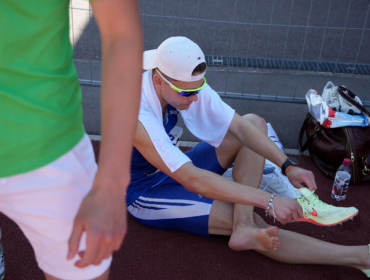Endurance sports are very trendy and, so is triathlon for example. But how do we all who are busy all day long achieve the training volumes of 12 to 14 hours per week, a minimum that is assumed necessary to race a long distance triathlon race or a marathon? There are different approaches to what is considered efficient training. Some of the elite athletes are convinced that long training cycles are necessary to get into good form, while others favor qualitatively high-intensity training sessions. The proof of concept is still missing, because there are athletes in either group who are successful, as there are those who are not.
In my opinion, here we stumble into the same troubles as everywhere, if we want to define one rule for everybody. I know athletes who train comparatively very little and achieve a lot. Whether this is a concept for everyone is not known, I myself. I doubt it. But there are studies on the way supporting high-intensity interval training. I have digged one that indicates that high-intensity interval training may compensate up to certain extent for long training session of low intensity around 65% V02 max.
It is an exciting perspective reading that 2.5 hours sprint units at ca 90% Vo2 max per week compared to 10.5 hours low-intensity running may be as efficient in outcome.
The group around Gibala and McGee from Ontario, Canada and Melbourne, Australia defines high-intensity interval training (HIT) as follows: 30 seconds of all-out maximal cycling against a high braking force on a specialized ergometer (Wingate test). Their standard protocol involved subjects repeating the Wingate test four to six times separated by 4 minutes of recovery for a total of only 2 to 3 minutes of very intense exercise per training session, with three training sessions performed each week for 2 to 6 weeks. The most unique aspect of their work has been the very low training volume, equivalent to approximately 300 kJ of very intense exercise per week.
One of the most remarkable findings from the recent studies was the dramatic improvement in exercise performance during tasks that rely mainly on aerobic energy metabolism, despite the very low training volume. Subjects doubled the length of time that exercise could be maintained at a fixed submaximal workload from approximately 26 to 51 min during cycling at 80% of pretraining VO2peak – after only 6 HIT sessions over 2 weeks. The validity of this finding was bolstered by the fact that a control group showed no change in performance when tested 2 weeks apart with no training intervention.
This is very promissing evidence for those of us whose main argument of not getting into shape is lack of time, and moreover, no excuses anymore 😉
Of course, there remain reservations concerning the final interpretation of the results. HIT may differ from traditional endurance training with respect to changes induced in the cardiovascular and respiratory systems, metabolic control in other organs (e.g., liver, adipose tissue), and protection from disorders associated with chronic inactivity (e.g., insulin resistance, lipid dysregulation).
The answers to the fundamental questions regarding the minimum volume of exercise necessary to improve physiological well-being in various populations, the effectiveness of alternative (less extreme) interval-training strategies, and the precise nature and magnitude of adaptations that can be elicited and maintained over the long-term are still missing.
Nevertheless, for those among you who train anyway and struggle first of all with time, the HIT approach could at least be a partial solution of the dilemma.
Source: Gibala MJ, McGee SL: Metabolic Adaptations to Short-term High-Intensity Interval Training: A Little Pain for a Lot of Gain?: Exercise and Sport Sciences Reviews, 58-63, 2008




